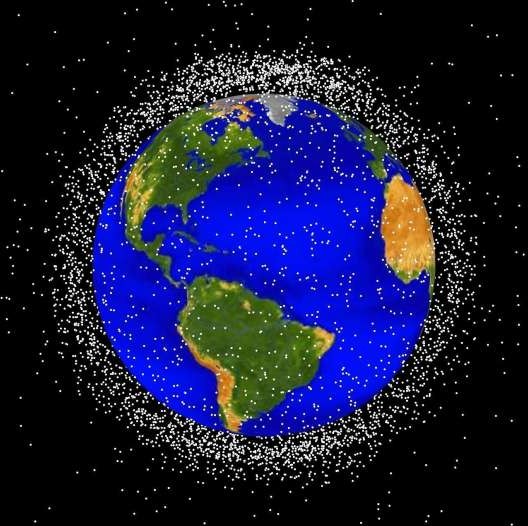Palmer Labs Dr. Miles Palmer
https://www.linkedin.com/in/milespalmer/
The possibility of space junk increasing exponentially -- this will certainly happen someday if we do nothing -- could turn low Earth Orbit into a killing field that would destroy everything in it. How long do we have before it is too late? Years? Decades?
Perhaps just months?
 |
Pictured above, space junk that NASA was tracking as of 2019.
So many things for which we hope:
Mining asteroids for precious metals for export to Earth.
Human habitats on the Moon and Mars.
Massive detection systems capable of finding life elsewhere in our galaxy -- or even further away.
However, the scenario of the movie Gravity is becoming more and more likely. Already the International Space Station has had to dodge deadly space junk 30 times, most recently Dec. 3, 2021.
Nothing in low Earth orbit will be able to survive for long unless we succeed in cleaning up orbital junk before exponentially increasing collisions might turn low Earth orbit into a killing field that nothing there could survive. Already three satellites have been accidentally destroyed, the first, in 1996, by a collision with space junk, and the next two in 1999 by a collision between them. Indeed, we might be on the cusp of a disaster like that of the movie Gravity (a different trailer at this linkNovember 12, 2021, the International Space Station had to dodge a fragment of the Fengyun-1C spacecraft, destroyed Jan 11, 2007 by a Chinese antisatellite missile. November 15, 2021, a Russian antisatellite missile blew up a defunct satellite of theirs, creating an expanding killing field that so far has narrowly missed the International Space Station.
According to a statement later that day by NASA, a “precautionary measure of sheltering the crew was executed for two passes through or near the vicinity of the debris cloud. The crew members made their way into their spacecraft shortly before 2 a.m. EST and remained there until about 4 a.m. The space station is passing through or near the cloud every 90 minutes, but the need to shelter for only the second and third passes of the event was based on a risk assessment made by the debris office and ballistics specialists at NASA’s Johnson Space Center in Houston.” For updates about the International Space Station, its research, and its crew, see https://www.nasa.gov/station.
According to NASA, “There are approximately 23,000 pieces of debris larger than a softball orbiting the Earth. They travel at speeds up to 17,500 mph, fast enough for a relatively small piece of orbital debris to damage a satellite or a spacecraft. There are half a million pieces of debris the size of a marble or larger (up to 0.4 inches, or 1 centimeter) or larger, and approximately 100 million pieces of debris about .04 inches (or one millimeter) and larger. There is even more smaller micrometer-sized (0.000039 of an inch in diameter) debris.
“Even tiny paint flecks can damage a spacecraft when traveling at these velocities. A number of space shuttle windows were replaced because of damage caused by material that was analyzed and shown to be paint flecks. In fact, millimeter-sized orbital debris represents the highest mission-ending risk to most robotic spacecraft operating in low Earth orbit.” Source https://www.nasa.gov/mission_pages/station/news/orbital_debris.html.
“On July 24, 1996, the first collision between an operational satellite and a piece of space debris took place when a fragment from the upper stage of a European Ariane rocket collided with Cerise, a French microsatellite. Cerise was damaged but continued to function. The first collision that destroyed an operational satellite happened on February 10, 2009, when Iridium 33, a communications satellite owned by the American company Motorola, collided with Cosmos 2251, an inactive Russian military communications satellite, about 760 km (470 miles) above northern Siberia, shattering both satellites." Source: https://www.britannica.com/technology/space-debris#ref1104221
“On February 10, 2009, an inactive Russian communications satellite, designated Cosmos 2251, collided with an active commercial communications satellite operated by U.S.-based Iridium Satellite LLC.1 The incident occurred approximately 800 kilometers (497 miles) above Siberia. This collision produced almost 2,000 pieces of debris, measuring at least ten centimeters (4 inches) in diameter, and many thousands more smaller pieces. Much of this debris will remain in orbit for decades or longer, posing a collision risk to other objects in Low Earth Orbit (LEO). This was the first-ever collision between two satellites in orbit." Source: https://swfound.org/media/6575/swf_iridium_cosmos_collision_fact_sheet_updated_2012.pdf
Jan 11, 2007, the Chinese military destroyed China’s defunct Fengyunci weather satellite in a test of its antisatellite weapon, creating Source: https://www.space.com/3415-china-anti-satellite-test-worrisome-debris-cloud-circles-earth.html
See also https://www.wired.com/story/the-us-space-force-wants-to-clean-up-junk-in-orbit/.
Dr. Palmer has been working on a solution to this problem: Thor
Details on Dr. Palmer's Thor patents -->
Other patents of Dr. Palmer's -->